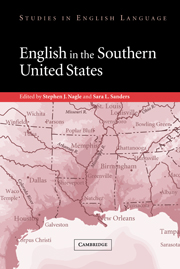Book contents
- Frontmatter
- Contents
- Notes on the contributors
- Acknowledgments
- Introduction
- 1 The origins of Southern American English
- 2 Shakespeare in the coves and hollows? Toward a history of Southern English
- 3 Eight grammatical features of southern United States speech present in early modern London prison narratives
- 4 The shared ancestry of African-American and American-White Southern Englishes: some speculations dictated by history
- 5 The complex grammatical history of African-American and white vernaculars in the South
- 6 Grammatical features of southern speech: yall, might could, and fixin to
- 7 Sounding southern: a look at the phonology of English in the South
- 8 Vowel shifting in the southern states
- 9 Enclave dialect communities in the South
- 10 Urbanization and the evolution of Southern American English
- 11 The Englishes of southern Louisiana
- 12 Features and uses of southern style
- References
- Index
4 - The shared ancestry of African-American and American-White Southern Englishes: some speculations dictated by history
Published online by Cambridge University Press: 22 September 2009
- Frontmatter
- Contents
- Notes on the contributors
- Acknowledgments
- Introduction
- 1 The origins of Southern American English
- 2 Shakespeare in the coves and hollows? Toward a history of Southern English
- 3 Eight grammatical features of southern United States speech present in early modern London prison narratives
- 4 The shared ancestry of African-American and American-White Southern Englishes: some speculations dictated by history
- 5 The complex grammatical history of African-American and white vernaculars in the South
- 6 Grammatical features of southern speech: yall, might could, and fixin to
- 7 Sounding southern: a look at the phonology of English in the South
- 8 Vowel shifting in the southern states
- 9 Enclave dialect communities in the South
- 10 Urbanization and the evolution of Southern American English
- 11 The Englishes of southern Louisiana
- 12 Features and uses of southern style
- References
- Index
Summary
Introduction
Speculations, conjectures, and hypotheses on the genetic relationship between African-American Vernacular English (AAVE) and American White Southern English (AWSE) date from the colonial period. Travelers to the American colonies often observed that blacks and whites spoke alike. Some of them even conjectured that the then emergent AWSE was influenced by its AAVE counterpart. As late as the 1990s, this view was still reflected by linguists such as Feagin (1997), who attributes to AAVE influence the southern drawl, non-rhoticism (or r-lessness), and falsetto pitch (apparent musicality).
The similarities between AAVE and AWSE are real. Non-Southerners have even often remarked that they were unable to determine whether a speaker was black or white unless they saw them. There is as yet no consensus on whether these ethnic varieties are so similar because the (descendants of) Africans influenced the speech of the (descendants of) Europeans up to the late nineteenth century or because of other reasons. I argue below, on sociohistorical grounds, that while AWSE and AAVE have undoubtedly influenced each other, their commonalities can be explained primarily by their common, coextensive histories of over 200 years during which their speakers interacted regularly with one another. Many of today's differences between the two vernaculars can be attributed to the divergence that resulted from the widespread institutionalization of segregation in the late nineteenth century.
It has also often been observed that an English koiné developed in the American colonies, which is the ancestor of at least today's American English vernaculars.
- Type
- Chapter
- Information
- English in the Southern United States , pp. 64 - 81Publisher: Cambridge University PressPrint publication year: 2003
- 4
- Cited by



